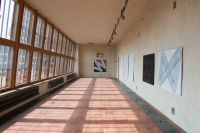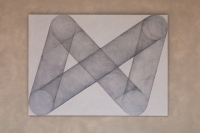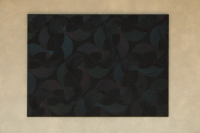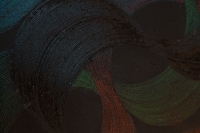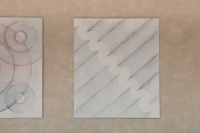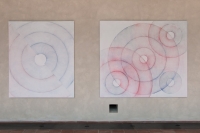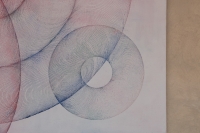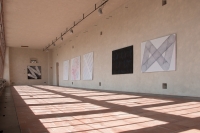Správný vzorec / Correct Formula
Entrance Gallery / 2013
Praha
Tisková zpráva
Obraz mezi psem a vlkem
Obrazová výstava Dana Vlčka v Entrance ukazuje jen jeden z mnoha umělcových záběrů na současné umělecké scéně. Vedle své vlastní vizuální tvorby se totiž věnuje i hudební produkci. A protože všechno souvisí se vším, ani tyto jeho dvě polohy nelze oddělit. Naopak. Je třeba je vnímat současně.
Touha po propojení zrakového a sluchového vnímání provázela i romantického fyziologa Jana Evangelistu Purkyně, který už ve svých raných pracích snil o optickém klavíru jezuity Louise-Bertranda Castela z 18. století, jenž by dokázal malovat zvuky. Podobnou vizi popsal o přibližně sto let později i Boris Vian ve své Pěně dní, když parodoval Castelův klavír tzv. "pianocoktailem", který proměňoval zvuky na chuťové a alkoholové zážitky. Přes Rimbaudovy Voyelles (barevné samohlásky) mají pak i přelomové snahy moderního umění mnohdy svůj předobraz v romantických snahách o synestézii. V elektrickém století Purkyňovy kresby figurace zvuků označil Goethe za přírodní hieroglyfy zaznamenávající univerzální harmonii.
V Danielových obrazech hraje hlavní roli rytmus. Sám umělec se v rozhovoru o svých malbách odkazuje k ritornelu v pojetí Deleuze a Guattariho, který překračuje původní definici lyrické básně o třech verších rýmovaných dle schématu "a b a". Ritornel je totiž zároveň spojením chaosu a řádu. Chaosu, který implikuje řád a naopak, dvě složky obsažené jedna v druhé, pokud přistoupíme na definici řádu jako rytmického chaosu. Danielovy malby tak předpokládají přítomnost rytmu. Tento rytmus přichází ve chvíli, kdy jedno médium přebírá fragmenty druhého média, vyskytuje se mezi dvěma rovinami, v meziprostoru a v mezičase. Totiž přesně někde mezi, když se Daniel proškrabává z horní vrstvy nátěru do spodní expresivně (a chaoticky) naneseného pigmentu. A pak je tu rytmus pravidelně se opakujících linií, které obkružují vinylové desky – single, EP nebo LP – a postupně tak vytvářejí nekonečný dron, harmonický tok tónů, respektive jeho výsek. Právě tato časovost je pro Danovy obrazy typická. A ne náhodou jsou tyto kompozice vytvářeny pomocí hudebních nosičů s nádechem nostalgie.
Při poslechu překrývajících se sekvencí opakujících se slov a zvuků náš mozek konstruuje konkrétní sdělení, která tam ve skutečnosti nejsou, neboť má potřebu vytvářet smysluplný vjem i z nesmyslného zvuku. Podobně tak i tyto obrazy vytvářejí iluzi hudební skladby, aniž by nás znásilňovaly do konkrétní melodie. Ta se sama časem dostaví. Je pouze na nás, jaká bude, důležité však je, že probíhá v čase. Na rozdíl od statického obrazu v ploše se tak malby stávají audiovizuálním dílem, výsečí právě probíhajícího procesu. Velká část lidského vnímání je výsledkem schopnosti našeho mozku vyplňovat mezery v datech, které přicházejí skrze smysly. Danielovy obrazy je tedy nutné poslouchat.
Protože digitální data dovolují libovolný překlad jednoho média do druhého, hranice mezi vizuálním a zvukovým kódem byla zrušena. Vlčkovy obrazy s tímto pracují i v rámci samotného média malby. Vizuální i zvukový kód se totiž i tady překlápí jeden v druhý. Daniel si svérázně vypůjčuje hudební techniky. Pracuje intuitivně, přesto jistě a přesto rytmicky. Pracuje s vědomím, že jsou naše představy dotvářeny pamětí a zkušeností, kterou nelze ignorovat. Jeho obrazy jsou tedy fúzí viděného a slyšeného stejně tak, jako propojením audiovizuálního díla probíhajícího v čase a jeho vlastního statického záznamu v ploše. Tyto záznamy zůstávají někde mezi. Přesně tam, kde se nachází cosi mezi psem a vlkem.
Tereza Velíková
Press release
Somewhere in between Dog and Wolf
The exhibition of Daniel Vlček's paintings in Entrance Gallery shows only a segment of what the artist focuses on within the arts, another of his specializations being music production. And because everything is interconnected, also these two fields are closely linked. In fact, they need to be perceived simultaneously.
It was also the romantic philosopher Jan Evangelista Purkyně who longed to connect visual and audio perception, and in his early works, he dreamt of Jesuit Louis-Bretrand Castel's ocular piano from the 18th century, a piano that would paint sounds. About a hundred years later, a similar vision was described by Boris Vian in his Foam of the Days when he used a "pianococktail" as a parody of Castel's piano. The pianococktail was meant to change sounds into taste and alcoholic sensations. And there have been other revolutionary experiments of modern arts, such as Rimbaud's Voyelles (vowels linked to a colour) which have been inspired by romantic attempts of synesthesia. In the electric century of Purkyně's drawings, Goethe described the visual representation of sounds as natural hieroglyphs transcribing the universal harmony.
Rhythm is essential to Daniel's paintings. In one of the interviews about his paintings, the artist himself refers to ritornello as understood by Deleuze and Guattari: it surpasses the original definition of ritornello as a lyrical poem of three verses rhymed according to a b a scheme. He perceives ritornello as a synthesis of chaos and order. Chaos implies order and vice versa, and if we accept the definition of order as rhythmic chaos, the two elements are contained one in the other. Thus, Daniel's paintings imply the presence of rhythm. This rhythm appears when one medium takes over the fragments of the other; it exists in between two planes, in interspace and interim, specifically somewhere in between the moment and the place when Daniel scrapes through the upper layer of the painting down to the bottom layer of expressively (and chaotically) applied pigment. And then there is the rhythm of regularly repeated lines circumscribing vinyl plates (singles, LPs or EPs) and creating an endless drone, a harmonious flow of tones, or rather its segment. This temporality is typical of Daniel's paintings. And of course, the use of records tinged with nostalgia is no coincidence.
When we hear some random overlapping sequences of words and sounds, our brain tries to give them a meaningful content which, in fact, isn't there because we tend to make sense of sounds even if they don't make any. Similarly, these paintings create an illusion of a piece of music without imposing on us a specific melody. The melody comes by itself later, and it's only up to us what melody it will be. What matters is that it progresses in time. Contrarily to static and two dimensional pictures, the paintings become an audiovisual work of art, a segment of continuous process. A great part of human perception originates in brain's ability to fill in the gaps between inputs coming in through our senses. Therefore it is vital to listen to Daniel's paintings.
As digital data can be transferred from medium to medium, the boundaries between visual and audio codes have been effaced. Daniel works with this fact even within the realm of painting itself. Both visual and audio codes merge. Daniel makes use of various music techniques in an original way. He works intuitively, yet with precision, and yet rhythmically. He works with the fact that our imagination is completed by our memories and experiences which we cannot ignore. His paintings are a fusion of the seen and the heard as well as a merge of audiovisual works in time and their static two dimensional records. These records remain somewhere in between. Somewhere in between dog and wolf.
Tereza Velíková
